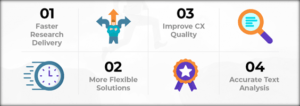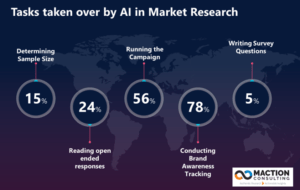Artificial Intelligence and Machine Learning are no longer some complex technical jargon. In our day to day life, face recognition, personalized shopping reviews, and smart personal assistants like Siri, Alexa, and Echo are all examples of AI in action.
As AI technologies are becoming more affordable and accessible, market research firms are using them actively for research operations. According to a report, the market research conducted through Artificial Intelligence is expected to clock a revenue of $ 200 billion in 2025.
But why market research firms are using AI-based solutions?

Faster research delivery: For the research insights to remain relevant, market research must be completed as soon as possible. Delivery delays often result in out-of-date information and erroneous sentiment analysis. AI is helping firms to automate the manual processes and implement smart checks to reduce the overall turnaround time.
More Flexible Solutions: By incorporating consumer responses into surveys, AI technology makes them more engaging and adaptable. Computer learning technology enables more complex analysis and assists in the modification of existing tools to better meet the needs of customers.
Improve CX Quality: Traditional CX analysis approaches are improved by AI. The results of the research are delivered easily, reliably, and without any human mistakes or biases. The result is spot-on market research that is fast and granular.
Accurate Text Analysis: AI-powered algorithms sift through the millions of terms, conduct high-quality text analysis, and reveal what consumers are thinking, feeling, and searching for in the current market. AI technology analyses thousands of text messages, feedback, and survey responses in real-time, using both Natural Language Processing (NLP) and Sentiment Analysis.
By incorporating consumer responses into surveys, AI technology makes them more interactive and adaptable. Computer learning technology enables more complex analysis and aids in the modification of existing tools to better serve consumers. When a process is automated, even in its most complicated forms, software follows the instructions it is given. – time the process runs, the program (or machine) makes no decisions or learns something new.
AI use cases in Market research?
There is already a range of ways that artificial intelligence can provide researchers with observations and analysis that were previously unavailable. The ability to process massive, unstructured datasets is particularly noteworthy.

A. Determining Sample Size
You don’t have to wait until you have a lot of data to use AI. Indeed, market analysts are beginning to see how beneficial it can be much earlier in the process. For example, you can use AI to evaluate a larger pool of respondents, weeding out those who don’t meet your criteria and resulting in a more qualified shortlist of candidates.
B. Reading Open-ended Responses:
This is demonstrated in effect by the Google Cloud Natural Language API. As an example, the program recognizes “AI” as the most important entity in the first paragraph of this article (i.e. the most central to the text). It can also recognize the type of text, its syntactic form, and provide sentiment analysis.
When used on a wide scale, this can and the time it takes to analyze qualitative responses from days to seconds, which is especially useful when dealing with open-ended results
Fortunately, AI-driven behavioral forecasts reduce the chance of disengagement. Person interaction profiles are built by evaluating a wide range of data points about community members, such as the number of logins, pages visited, and time between logins.
The AI will classify the members who are at risk of being disengaged once it has been installed and compared to disengaged members. This enables community managers to provide additional support and motivation to these people, lowering the risk.
This ensures that a group managed with AI assistance will lose fewer members to disengagement over time than a community-managed without AI assistance.
Artificial intelligence-driven behavioral forecasts can recognize members of the research community who are on the verge of leaving. However, moderators must also decide about how to handle the situation.
C. Running Campaigns:
Finding great content, effectively delivering it to the audience and weeding results out of it is what the campaign is all about. Nike uses AI to understand the customer and recommend those products to the customer which he is likely to buy, thereby enhancing the user experience. Likewise, AI campaigns can be curated and posted only to that audience who are more likely to click and actively participate in them.
D. Conducting Brand Awareness Tracking:
Opinions will spread like wildfire on social media! You probably already know how effective word of mouth and social media posts can be in building or undermining a company’s credibility. Aside from social media, online customer review platforms are another type of digital media that businesses should be aware of. Artificial intelligence has been used to create applications that help businesses protect their online reputation. Companies may use these systems to achieve sophisticated brand management. This is accomplished by allowing brand and product managers to perform large-scale research and analysis on social media networks, blogs, news websites, and other online forums.
E. Writing Survey Questions:
Artificial Intelligence can identify problems associated with the brand. They can also understand the major concern of the customers, hence write survey questions that will serve the purpose of market research campaigns and lead to its optimal efficacy.
Emerging technologies in 2021
Of course, time does not standstill. Artificial intelligence is still in its infancy, but it is a technology that will have a much larger effect on market research in the years to come. While it’s impossible to say with certainty what effect this would have, the ideas discussed here are already in the works — and could arrive sooner than we expect.
A. Virtual Market Research & Forecasting
It is costly to recruit new employees. In reality, depending on the size of the sample and the duration of the mission, it can rapidly deplete a research budget. Building a virtual panel of respondents based on a much smaller sample is one proposed concept for lowering this expense and stretching insights budgets much further. According to the theory, sample sizes limit a brand’s ability to consider the behavior of any potential customer.
There are several drawbacks to this approach, including the possibility that virtual respondents would initially be limited to binary responses. However, this still has value, especially when combined with the ability to run a large number of virtual experiments at the same time. This may be used to figure out the best price point for a product or to figure out how people respond to a certain situation.
B. Chatbots & Virtual Moderators
The question of whether artificial intelligence may be used to conduct large-scale conversational qualitative research remains unanswered. Today’s research chatbots are limited to pre-programmed questions posed in an online conversation-like user interface. However, as AI progresses, these online query delivery formats can evolve as well.
C. Conducting Secondary Research
Main research isn’t always primary research. In reality, secondary or desk research is the most cost-effective choice for many smaller businesses. However, in broader insight teams looking to reach new markets, create new products, analyze competitor results, or evaluate supply chains, it can be a useful tool.
Desk analysis has a natural resource constraint. Although desk research is beneficial, it can be time-consuming, which means that information does not always meet decision-makers until a decision is made. Artificial intelligence can read, learn patterns, and recognize trends much faster than a person, making this a potentially useful application of the technology.
Obtaining content for the AI to process is the current roadblock to adoption. This barrier is gradually eroding as more and more information is archived on public and private networks.
Bottom Line
Artificial Intelligence has come a long way since its inception, and it is now influencing the future of marketing. It’s up to you to put this technology to use in your business. But one thing is certain: AI is the way of the future. Using AI-powered marketing and software is a must if you want to run a profitable online company in the coming years.


